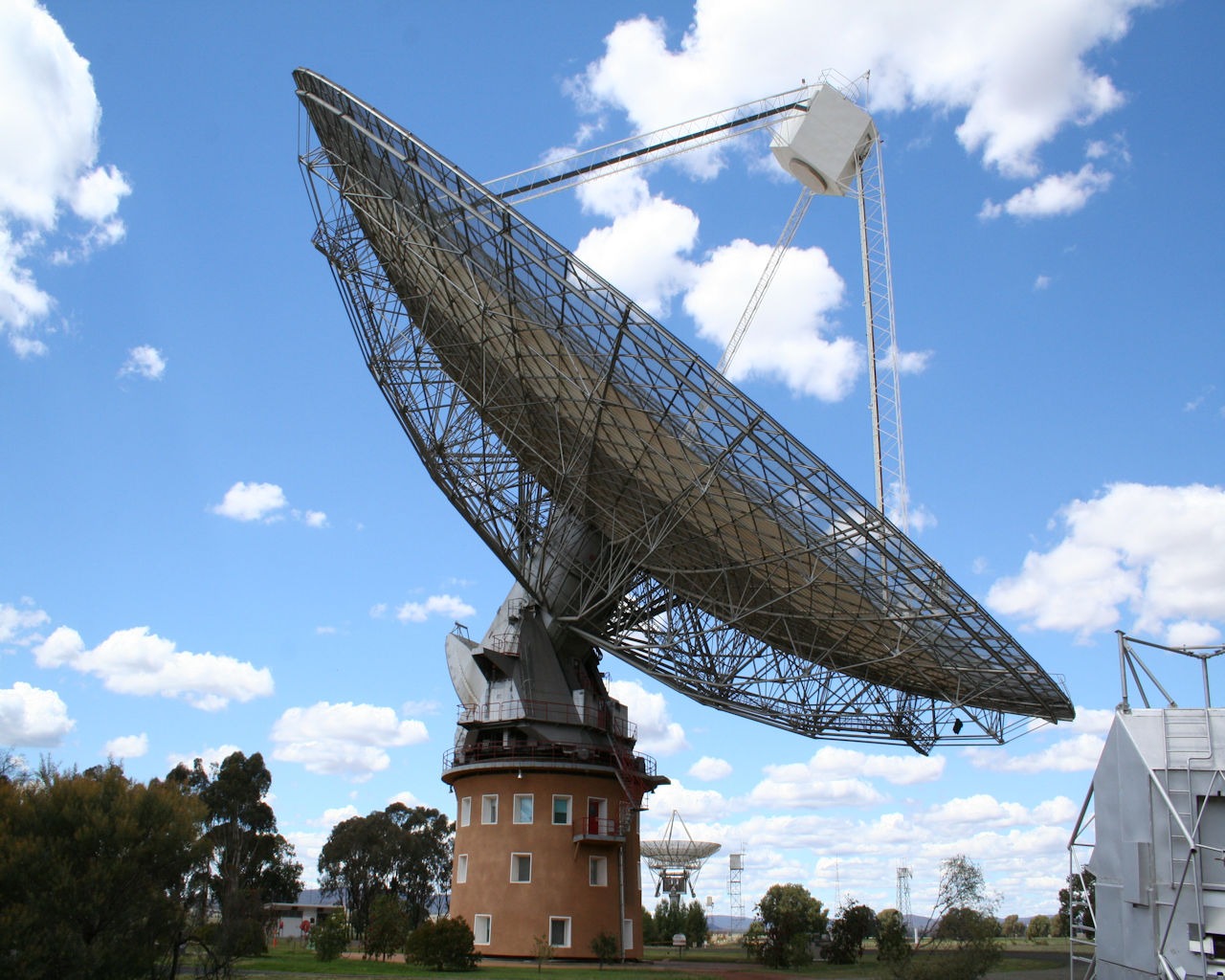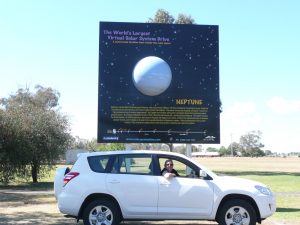Astronomy Down Under
I’ve been lucky enough to visit Australia three times.
My most recent visit was just a month ago.
So I thought that this might be a good time to look at Astronomy down under.
Davidson High School
This year I was invited by Davidson High School in Sydney to give a talk.
We took a journey through the universe, from the Solar System to the farthest galaxies.
Dennis with students at Davidson High School.
I would like to thank the staff and all the students for their warm reception.
This blog is dedicated to you.
Australian Observatories
Australia has two world class observatories.
Both are in New South Wales.
Parkes Radio Telescope
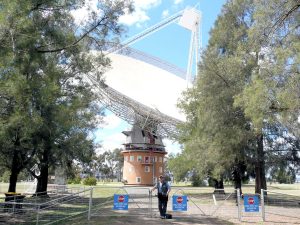
Author Dennis at Parkes Radio Astronomy Observatory
Parkes radio observatory is 220 miles west of Sydney, New South Wales.
The 64-metre Murriyang dish dominates the site.
It was built in 1961 but upgraded recently, making it 10,000 times more sensitive.
The central part of the disc is solid metal whilst the outer rim is metal mesh.
The observatory has made significant astronomical discoveries.
It has completed two all sky surveys in radio wavelengths.
In 1962 it helped pinpoint the first quasar, quasar 3C273 and determine the nature of these powerful radio sources.
Parkes has discovered more than half of known pulsars.
It is now involved in an international programme to detect gravity waves.
Another intriguing international project is Breakthrough Listen.
Here Parkes is listening for radio signals from planets inhabited by intelligent aliens.
One of Parkes discoveries was emphatically non-extraterrestrial.
In the 1990s, the telescope detected radio burst signals.
There origin was a mystery until 2015.
Then astronomers discovered that the signals were coming not from space but from their microwave oven when they opened the door!
Clearly, Parkes is a leader in astronomical research. But it is most famous for its part in the Apollo Moon landings.
After Neil Armstrong and Buzz Aldrin had set foot on the Moon, the Parkes dish relayed the rest of the historic broadcast.
This momentous event is recounted in the movie The Dish.
Parkes has also tracked many other space missions.
They include the Voyager missions, Giotto, Galileo and Mars rovers.
Siding Springs Observatory
Australia’s premier optical astronomy site is near Coonabarabran, also in New South Wales.
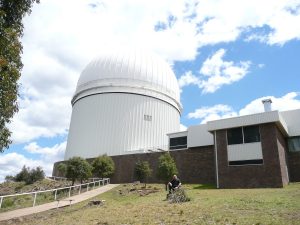
Dennis and the AAT dome. Photo: D. Ashton
Siding Springs Observatory houses telescopes from countries all over the world.
The biggest instrument is the 3.9 metre Anglo-Australian Telescope, AAT.
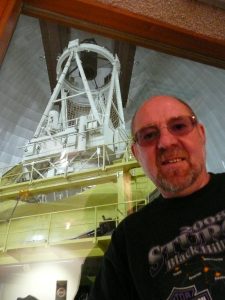
Dennis and the Anglo-Australian Telescope
The AAT came to my attention in the 1970s, through the work of David Malin.
David was using glass plates to photograph objects in the southern sky.
He took exposures in red, green and blue light.
Then he added the images together.
The result was true colour images of deep space objects, nebulae and galaxies.
This technique is now used in the age of digital images.

In order: Galaxy M83, Horsehead & Flame Nebula, Globular Cluster NGC 6752
Credit David Malin. Anglo-Australian Telescope.
The World’s Largest Solar System Drive
There’s a great bonus in visiting Siding Springs.
On the Newell Highway into Coonabarabran, there’s the worlds largest Solar System Drive.
The dome of the AAT represents the Sun.
The planets are represented to scale on huge roadside billboards.
The distances are also to scale, with Pluto 200km from the observatory.
It’s quite a drive!
Dennis at Neptune on the Solar System Drive. Photo: Dennis Ashton
My photo was taken at Neptune, still 133 km from Siding Springs Observatory.
By the time I reached Earth, there were only 1.5km to go.
Stars of Australia
The southern night sky is completely different to the northern sky I know so well.
In Australia we see stars in the southern celestial hemisphere.
These stars are not on view in Britain.
We share some equatorial constellations like Orion.
But in Australia they appear upside down!
If you want to see the night sky down under, you don’t need to board a plane.
Stellarium will show you the southern stars and constellations at home.
First Nation Legends
My daughter, who lives in Sydney, bought me a book about the southern stars.
It is The First Astronomers by Duane Hamacher.
It looks at the sky through First Nation Aboriginal eyes.
Stories written in the night sky have passed down through generations over thousands of years.
Here’s my favourite.
It involves the constellation of Orion, the Hyades star cluster and the Seven Sisters cluster.
To these First Nation people, Orion was Nyeeruna.
Like Orion, he was a famous hunter.
But Nyeeruna was a hunter of women as well as animals.
Every night he pursued the Yugarilya Sisters.
We know them as the Seven Sisters, the Pleaides.
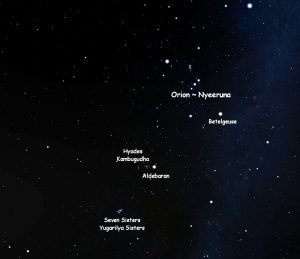
Orion & Taurus from NSW, Australia. Image: Stellarium.
Between Nyeeruna and the sisters lies a cluster of stars, Kambugudha.
We know her as the Hyades cluster in Taurus.
In the cluster is the red star Aldebaran.
Kambugudha knows that Nyeeruna is really a coward.
As he chases the sisters, she makes fun of him.
Nyeeruna becomes very angry at her taunts.
In response, he produces fire in his club – the red star Betelgeuse.
Kambugudha fights back with fire.
She kicks sparks towards him with the red star Aldebaran.
Kambugudha wins the fight.
Nyeeruna’s fire magic, Betelgeuse, fades again.
There is a wealth of astronomy hidden in this story.
In the story, both Betelgeuse and Aldebaran brighten and dim over time.
This represents the fire magic and sparks.
Betelgeuse and Aldebaran are in fact variable stars.
Their brightness increases and dims over time in a cycle.
The first variable star identified by European astronomers was Mira, in 1638.
But First Nation people in Australia knew that some stars changed brightness long before.
These Aboriginal people were remarkable observers of the night sky.
Star Talk
On my final day in Australia, I strolled round Sydney Harbour.
There I met a didgeridoo musician playing for the tourists.
He called me over to speak to him.
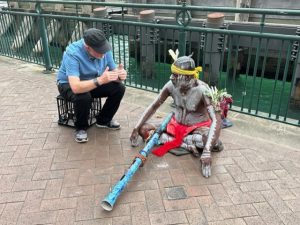
Dennis and the First Nation didgeridoo musician.
We talked about the importance of starlore in First Nation culture.
The stars were timekeepers and calendars.
They showed when to plant crops and when animals would breed.
The stars were an integral part of life.
And how I envy their clear, dark, starlit skies!
If you ever visit Australia, there is a wealth of astronomical interest there.
For those lucky enough to live in this vibrant country, you have a wonderful cosmic heritage.
The author: Dennis Ashton is a Fellow of the Royal Astronomical Society and a Wonderdome presenter.
Would you like to hear more Astronomy news?
Do you want to to find out about our upcoming public events?
Follow WonderDome Portable Planetarium on Twitter and Facebook or go to our web site wonderdome.co.uk

